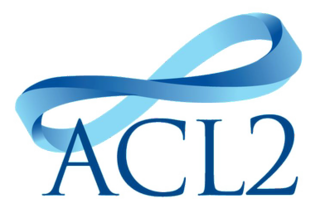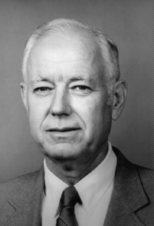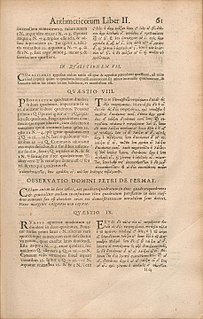
In mathematics, the four color theorem, or the four color map theorem, states that no more than four colors are required to color the regions of any map so that no two adjacent regions have the same color. Adjacent means that two regions share a common boundary curve segment, not merely a corner where three or more regions meet. It was the first major theorem to be proved using a computer. Initially, this proof was not accepted by all mathematicians because the computer-assisted proof was infeasible for a human to check by hand. The proof has gained wide acceptance since then, although some doubters remain.

Georg Ferdinand Ludwig Philipp Cantor was a German mathematician. He created set theory, which has become a fundamental theory in mathematics. Cantor established the importance of one-to-one correspondence between the members of two sets, defined infinite and well-ordered sets, and proved that the real numbers are more numerous than the natural numbers. In fact, Cantor's method of proof of this theorem implies the existence of an infinity of infinities. He defined the cardinal and ordinal numbers and their arithmetic. Cantor's work is of great philosophical interest, a fact he was well aware of.
Knowledge representation and reasoning is the field of artificial intelligence (AI) dedicated to representing information about the world in a form that a computer system can use to solve complex tasks such as diagnosing a medical condition or having a dialog in a natural language. Knowledge representation incorporates findings from psychology about how humans solve problems and represent knowledge in order to design formalisms that will make complex systems easier to design and build. Knowledge representation and reasoning also incorporates findings from logic to automate various kinds of reasoning, such as the application of rules or the relations of sets and subsets.
Gödel's incompleteness theorems are two theorems of mathematical logic that are concerned with the limits of provability in formal axiomatic theories. These results, published by Kurt Gödel in 1931, are important both in mathematical logic and in the philosophy of mathematics. The theorems are widely, but not universally, interpreted as showing that Hilbert's program to find a complete and consistent set of axioms for all mathematics is impossible.
Logic for Computable Functions (LCF) is an interactive automated theorem prover developed at Stanford and Edinburgh by Robin Milner and collaborators in early 1970s, based on the theoretical foundation of logic of computable functions previously proposed by Dana Scott. Work on the LCF system introduced the general-purpose programming language ML to allow users to write theorem-proving tactics, supporting algebraic data types, parametric polymorphism, abstract data types, and exceptions.

ACL2 is a software system consisting of a programming language, an extensible theory in a first-order logic, and an automated theorem prover. ACL2 is designed to support automated reasoning in inductive logical theories, mostly for the purpose of software and hardware verification. The input language and implementation of ACL2 are written in Common Lisp. ACL2 is free and open-source software.
Ergodic theory is a branch of mathematics that studies statistical properties of deterministic dynamical systems; it is the study of ergodicity. In this context, statistical properties means properties which are expressed through the behavior of time averages of various functions along trajectories of dynamical systems. The notion of deterministic dynamical systems assumes that the equations determining the dynamics do not contain any random perturbations, noise, etc. Thus, the statistics with which we are concerned are properties of the dynamics.

Michael Moore is an American jazz musician who has lived in the Netherlands since 1982.

In computer science and mathematical logic, a proof assistant or interactive theorem prover is a software tool to assist with the development of formal proofs by human-machine collaboration. This involves some sort of interactive proof editor, or other interface, with which a human can guide the search for proofs, the details of which are stored in, and some steps provided by, a computer.

J Strother Moore is a computer scientist. He is a co-developer of the Boyer–Moore string-search algorithm, Boyer–Moore majority vote algorithm, and the Boyer–Moore automated theorem prover, Nqthm. He made pioneering contributions to structure sharing including the piece table data structure and early logic programming. An example of the workings of the Boyer–Moore string search algorithm is given in Moore's website. Moore received his Bachelor of Science (SB) in mathematics at Massachusetts Institute of Technology in 1970 and his Doctor of Philosophy (Ph.D.) in computational logic at the University of Edinburgh in Scotland in 1973.
Boyer–Moore may refer to:
In computer science, in particular in knowledge representation and reasoning and metalogic, the area of automated reasoning is dedicated to understanding different aspects of reasoning. The study of automated reasoning helps produce computer programs that allow computers to reason completely, or nearly completely, automatically. Although automated reasoning is considered a sub-field of artificial intelligence, it also has connections with theoretical computer science and philosophy.
The Moore method is a deductive manner of instruction used in advanced mathematics courses. It is named after Robert Lee Moore, a famous topologist who first used a stronger version of the method at the University of Pennsylvania when he began teaching there in 1911.

Woodrow Wilson "Woody" Bledsoe was an American mathematician, computer scientist, and prominent educator. He is one of the founders of artificial intelligence (AI), making early contributions in pattern recognition and automated theorem proving. He continued to make significant contributions to AI throughout his long career.
Robert Stephen Boyer is an American retired professor of computer science, mathematics, and philosophy at The University of Texas at Austin. He and J Strother Moore invented the Boyer–Moore string search algorithm, a particularly efficient string searching algorithm, in 1977. He and Moore also collaborated on the Boyer–Moore automated theorem prover, Nqthm, in 1992. Following this, he worked with Moore and Matt Kaufmann on another theorem prover called ACL2.
In mathematics, more specifically point-set topology, a Moore space is a developable regular Hausdorff space. That is, a topological space X is a Moore space if the following conditions hold:
Nqthm is a theorem prover sometimes referred to as the Boyer–Moore theorem prover. It was a precursor to ACL2.
In topology, the Bing metrization theorem, named after R. H. Bing, characterizes when a topological space is metrizable.

In number theory, Fermat's Last Theorem states that no three positive integers a, b, and c satisfy the equation an + bn = cn for any integer value of n greater than 2. The cases n = 1 and n = 2 have been known since antiquity to have infinitely many solutions.
Natarajan Shankar is a computer scientist working at SRI International in Menlo Park, California, where he leads the Symbolic Analysis Laboratory.








